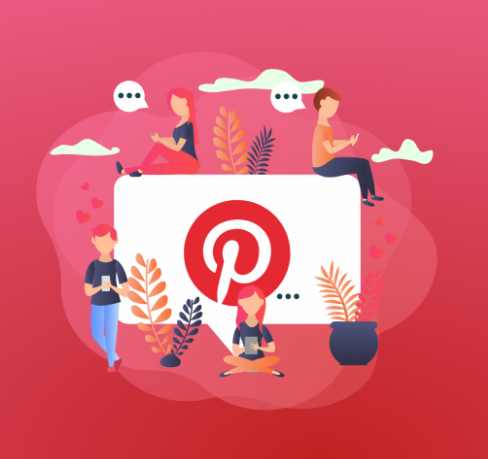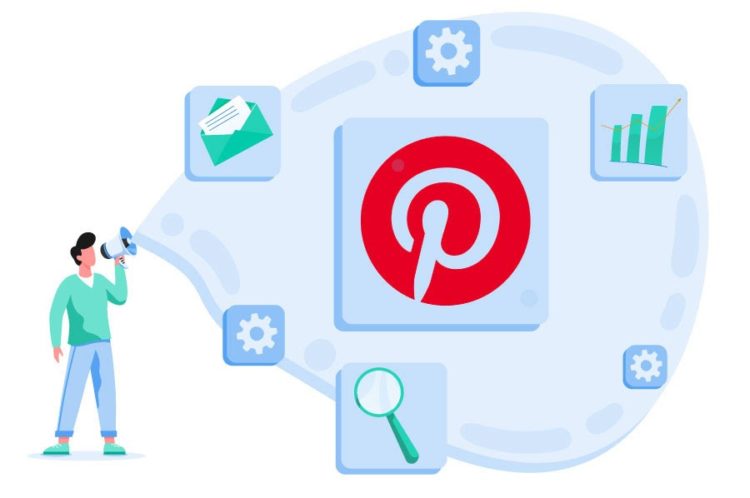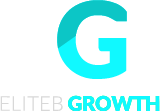Pinterest’s popularity is skyrocketing, but B2B firms aren’t taking advantage of it. Of course, Pinterest is fantastic for consumer-based businesses selling jewelry, clothing, or other image-based goods. However, as the platform’s viewership grows, people are drawn to it for various reasons. Pinterest users, regardless of industry, use the site to follow brands and companies, according to a third of them. Users go to Pinterest for various reasons, with the majority of them citing finding new recipes.
Do you still need more persuading? As the third most popular social media site in the United States, Pinterest has 320 million monthly active users that you’re losing out on. And it’s not only women who should be concerned about these things. According to recent data, more than half of all new members are male. Finally, even in the realm of business-to-business marketing, Pinterest is a great tool to have at your disposal. If we’re going to use it correctly, where do we start? The most excellent place to begin is studying the Pinterest marketing strategy employed by other well-known B2B firms.
Companies in the B2B sector are increasingly turning to Pinterest for marketing purposes.
If you’re still not sure that Pinterest marketing is right for your business, ask the experts in your field. IBM, Marketo, HubSpot, and Microsoft are just a few of the many B2B giants with active Pinterest strategies. Here are only a few examples:
IBM
As far as digital transformation goes, IBM is at the forefront. They’ve been at the forefront of a rapidly changing business for so long because of the innovative methods they’ve kept relevant to their target demographic. Their use of Pinterest shows how effective this technique can be. They’ve created their website with this in mind: many Pinterest users use the site to follow brands and get insider information on the companies they’re interested in. A few of the more popular of these boards are “IMB History” and “Women in Tech.”. IBM addresses its consumers differently by showing that they are not simply a corporation that sells products to their 6,000 active followers on IBM’s postings.
Matt Carter, Global Program Director for IBM Big Data & Analytics, described their content strategy as “not just ‘buy our stuff’ messaging, but educate the market, make them better consumers, provide the sort of information that they need to be more adept at big data and analytics in their own lives.” One of their most popular boards is an educational Infographic board, where they post a lot of instructional information for their target audience.
HubSpot
It’s no secret that digital marketers rely on HubSpot for up-to-date information on Inbound marketing. An example of an inbound strategy in action is the company’s Pinterest page. They repurpose their blog pieces and guides into bite-sized Pinterest pins to market the information they produce regularly. They’re giving their personas another way to educate themselves by making these pins more visually appealing.
HubSpot’s board, on the other hand, is heavily focused on infographics. They include boards dedicated to infographics for marketing and sales and other subjects of interest in their field. HubSpot teaches us that we shouldn’t limit ourselves to pinning our content. Pins from different companies are also plentiful in their collection. Brand trust is built by displaying other relevant industry thought leaders.
General Electric
Some of the world’s most prestigious manufacturing and engineering firms have joined Pinterest. Look at how GE makes use of the platform in the B2B market. Other boards promote brand awareness, such as “From the Factory Floor,” which shows production and engineering in action from the back of the house. Pins like “Fabulous Kitchens,” which showcase visually attractive kitchen models incorporating the GE brand, and “GE Lighting 100 Reveal,” which serves a similar goal by showcasing GE lighting in action, are included as well as other product-specific pins.
Several other pins on their Pinterest board can be used in nearly any sector to connect with their target personas while also being creative and easy to replicate. They’re also a frontrunner in the B2B Pinterest game, having more than 22,000 followers to their name.

Related Post: How to Create a TikTok Marketing Strategy for Your Online Store
There are five Pinterest marketing strategies for B2B companies that you should consider.
We may develop our game plan for the platform after learning from some of the top B2B firms. Here are five Pinterest marketing strategies for your B2B firm that you can put into action.
1.Make an effort to learn about the algorithms used by Pinterest:
An exciting feature of Pinterest is that it functions as a search engine. And, like with any search engine, a formula is used to decide the order in which Pins appear in search results. No one has a complete understanding of how the algorithm works, just like with Google. However, there are a plethora of ideas and tactics available to assist in ranking. You’ll be on the right track if you approach it the same way you do SEO for Google.
Search engine optimization methods and keywords should be balanced with creating useful, helpful, and fascinating content targeted towards searchers’ purposes. Here are a few simple suggestions to help you learn how to rank higher on Pinterest when you start studying keyword optimization for Pinterest:
- Make sure your material is appropriate to the boards to which it’s posted by checking for relevance. In this way, Pinterest will more efficiently distribute your Pins to the people who are most likely to find them interesting.
- Consistency – Pinterest will consider you an active user if you Pin frequently on your account. Pinterest promotes active and consistent pages with their updates by giving them a better position in search results.
- Make use of “rich pins,” which allow information from your website to be transmitted directly to the pin. Your page will remain current as long as your rich pins are kept up to date with your website.
- Pins of Superior Quality – Pinterest, like Google, favors postings that are well-written, informative, and recent. Due to the increased number of saves and comments generated by these posts, Pinterest will place them higher in search results and keep them there longer.
2. Make Your Pinterest Boards and Pins More Visible:
When it comes to social media, keywords are more essential on Pinterest than any other because of search and ranking. You may even improve your Google ranking by adequately optimizing your pins. It’s like getting two presents in one. So, how can we make Pinterest search engine friendly? Using relevant keywords in titles and descriptions is the quickest answer. Be sure to incorporate more than simply keywords into your pins. Your keyword approach must be maintained throughout all of your boards. It would be best if you kept in mind that boards may be searched, and Pinterest’s algorithm takes keywords used on a board into account when determining whether or not the information on a board is relevant to a search inquiry. The best approach includes your target keywords in your Pinterest page’s board title, description, and pins.
You should also include your keywords in the following places:
- Profile Bio
- Pin Descriptions
- Image Alt-text
So, how do you come up with the keywords for your Pinterest board? Use Google Analytics as a jumping-off point. Make your board names relevant to the keywords for which you presently rank highly in Google. Include your keywords in the description of the board and the pins linked with the board. Consider HubSpot as an illustration. “Marketing Infographics” is the name of their board on Pinterest. “Marketing infographics and data visualizations for marketers,” reads the board’s description.
Hashtags are essential, so don’t overlook them. Hashtags, like keywords, should be utilized on Pinterest. After your Pin descriptions, consider including 2-8 relevant keyword hashtags.
3.Create Visual Assets from Repurposed Content:
Let’s look at what kind of material you should use now that we can optimize it. Repurposing existing material is the most straightforward method to strengthen your Pinterest strategy. Assuming you’re using an inbound strategy, you’ve probably already spent some time on content marketing. Consider Pinterest to be an additional distribution channel for your material.
Keep in mind that Pinterest is primarily an image-based social network. Consequently, your postings must have an eye-catching design. Here are a few pointers to assist you in making your material more visually appealing to Pinterest:
- Pinterest’s highest performing pins are those that have a vertical orientation.
- Pinterest pictures should have a 2:3 or 1:3:5 aspect ratio.
- Twenty-three percent more Pins are given to branded pictures without faces.
- Photos with several colors get 3.25 times as many repins as images with only one color.
- Photos with more background content are more likely to be repinned than images with less background content.
- 70% of Pinterest users say they will watch sponsored videos on topics they’re interested in
You can more effectively reuse your material if you keep these ideas in mind. Consider generating pictures for the covers of e-books and the illustrations of blog posts. And infographics have already been shown to be successful on the platform. Consider your graphics as you set out your editorial schedule to make reusing material easier. This will not only improve your content’s overall performance on Pinterest, but it will also make the repurposing process go much more quickly and smoothly.
Be at ease; you don’t have to be a designer to make Pinterest-worthy pictures. Tools abound, many of which are free and straightforward to use. Some of our favorites are listed below:
- You can also use Canva to create infographics and board covers.
- PicMonkey is a fantastic picture resizing application.
- Templates for Pinterest may be found on Fotor.

Related Post: Twitter as a Marketing Tool: 5 Effective Marketing Strategies
4.Exhibit the brand and character of your business:
You’ll see a familiar pattern if you look at the Pinterest sites of the three B2B firms we mentioned before. Somehow, they’re all showcasing the character of their company’s brand.
Remember that one-third of Pinterest’s users go there to find and follow new companies. So please provide them with something new to uncover for them to explore. Take a positive approach to your company’s image. Also, show that your logo has a personality of its own.
Take a look at these famous B2B firms’ brand boards on Pinterest for some inspiration:
- The Cookbook of IBM’s Chef Watson
- Office 365: A Day in the Life
- FedEx: Throwbacks to the Old Days of FedEx
- Quotes from Intel Employees
- It’s all about culture at HubSpot!
Consider the following finding while choosing the sort of culture material you wish to promote on Pinterest. According to Pinterest Insights, six out of ten American people believe that they are more likely to recall companies they see online when they feel good about themselves. As a result, keep it light and humorous when writing your content. You want to show potential customers what your brand stands for and why they should put their trust in you.
5.Participate in Conversations with Other Users on the App:
There’s more to it than just the information you’re providing. A successful B2B Pinterest strategy necessitates participation and interaction with other users. Create brand loyalty by establishing personal connections with Pinterest users who are already fans of your business and even reaching out to those who aren’t. This keeps people coming back to your profile for new ideas. Here are a few Pinterest engagement strategies to get you started.
Follow Companies That Share Your Interests:
Start by increasing the number of accounts you follow. As a result, you’ll witness a rise in your fan base. Your material will be found by more people who could be interested in your sector as a whole if you follow companies comparable to your own. Consider also adhering to celebrities and influencers who are in line with your company’s goals. Users will have an easier time finding your profile if you link with more popular accounts.
Promote Useful Information:
Like many other best practices in social media, curated content always performs better and has a more significant impact on consumers. Repins account for 80% of all Pins on Pinterest. As a result, don’t limit your attention just to your contributions. Identify and repin information from other sources that would be of interest to your target audience. Additionally, this will demonstrate to your followers that you are concerned about more than just your company’s and brand’s success.
Respond to those who have an interest in your content:
Engage with users who pin or comment on your content. Businesses may utilize Pinterest’s direct messaging feature to contact individuals who have connected with their accounts. Here are some pointers for maximizing the effectiveness of direct messaging as a marketing tool.
- Consider sending a customized note to individuals who repin your content as a way to say thank you.
- Arrange for roundtable discussions with influential people in your field or with other like-minded individuals. This will assist people in forming personal connections with your brand as well as with one other.
- Think about providing those who repin your article with specialized content or follow-up information.
Create Message Boards for Your Group:
You may also establish group boards on Pinterest, which makes it easier to work with others. By enabling partners you select to add Pins and contribute ideas, you can take control of the conversation. Don’t forget to include those who are already involved with your profile and/or brand. As a result, they’ll feel more like your company’s brand ambassadors.

